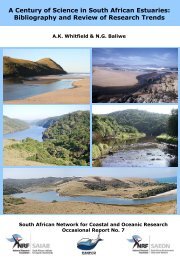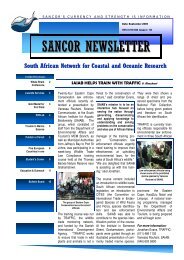SANCOR Newsletter -200 - Sancor home page - National Research ...
SANCOR Newsletter -200 - Sancor home page - National Research ...
SANCOR Newsletter -200 - Sancor home page - National Research ...
You also want an ePaper? Increase the reach of your titles
YUMPU automatically turns print PDFs into web optimized ePapers that Google loves.
Page 2<strong>SANCOR</strong> NEWSLETTER #<strong>200</strong>Surface velocies up to 2 m/s (~7 km/h)have been measured in the Agulhas, and atthe 30º latude, “our” current is significantlystronger when compared to its NorthernHemisphere counterparts: the Gulf Streamand the Kuroshio Current.The main funcon of western boundarycurrents are to transport warm tropicalwaters from the equator toward the poles,redistribung ocean heat and making thehigher latudes warmer. They form a vitalcomponent of the global oceanic conveyorbelt, whose role is to distribute heat oceanheat across the world’s ocean, therebyaffecng global climate and change.The conveyor belt system begins nearGreenland and Iceland in the North Atlanc.As the warmth of the Gulf Stream is lost tothe cold winds from Canada, the watersbecome denser and sink, forming a deepocean water mass known as North AtlancDeep Water. The newly formed water massthen flows southward along the sea floor to26‐27 Nov 197810‐13 Dec 197814‐27 Dec 1978The shedding of an Agulhas Ring observedfrom satellite infrared imagery.Agulhas Rings transport heat and saltinto the Atlanc Ocean vital for maintainingour present day climate. CourtesyLutjeharms and van Ballegooyen,1988.the Antarcc Connent whereit connues eastwards,warming and mixing as is goesand ulmately resurfaces in thePacific. Thereaer, it flows backto the North Atlanc along thesurface, compleng the globalconveyor and distribungocean heat across the globe. Ina warming climate, melng ofthe ice‐sheets from Greenlandand the Arcc might slow downor even stop the global oceanicconveyor belt. The AgulhasCurrent is an integral link in theglobal oceanic conveyor belt,transporng warm and saltywaters from the Indian to theAtlanc Ocean. This occurs directly south ofAfrica, where large Agulhas Rings (eddiescontaining warm and salty, tropical waters)are shed into the Atlanc Ocean. This “ringshedding” process is known as the Agulhasleakage, and is considered to be the mainmechanism through which warm and saltywaters are transported into the AtlancOcean.Paleoclimac studies, combined withsimulaons from numerical models havesuggested that an Agulhas leakage shutdownis associated with extreme glacial periods,whereas a vigorous increase has precededshis towards interglacials. These changesare largely associated with the thermohalinecirculaon driving the ocean conveyor belt,otherwise termed the MeridionalOverturning Circulaon. It now appears thatthe input of warm, salty waters from theAgulhas into the Atlanc Ocean is vital interms of counter‐acng the recentfreshening in the North Atlanc due to icemelt.Despite the monumental advancements intechnology, sampling the ocean remains acostly task. Observaons of the ocean areSea surface temperatures measurements of the AgulhasCurrent from SEVIRI overlaid with geostrophiccurrents derived from almetry measurements of thesea level. Courtesy: Marjolaine Krug (CSIR - EarthObservaon).limited to its surface from satellites, or pointmeasurements by ship‐borne orautonomous instruments. Numerical oceanmodels that represent ocean circulaonmathemacally allow us to gain deeperunderstanding of processes occurring in theocean. Because of the paucity of oceanobservaons, in parcular for the AgulhasCurrent and Southern Ocean, studies ofthese regions have relied heavily onnumerical models. These models haverevealed a possible increase in Agulhasleakage and have implied climate relatedchanges on a global scale.However, the Agulhas Current is one of themost difficult regions in the world to modelaccurately. This is because of its extremelyturbulent nature and our limitedunderstanding of the processes that drivethe system. The ocean dynamics in theAgulhas are largely dominated by eddies andmeanders of the order of 100’s ofkilometers. Model simulaons of thesefeatures vary significantly as these aredependent on the resoluon of the model,and the parameters used to specifyprocesses that we cannot resolve explicitlysuch as mixing, viscosity and diffusion. In







